


“What is Freeride Mountain Biking”
Freeride mountain biking is like the BMX of the mountains. Riders tackle natural terrain, performing jumps, tricks, and stunts. It’s the ultimate mix of creativity and adventure, like painting your biking story on the trails.
Imagine a playground on hills where riders express themselves freely, blending skill and style for an adrenaline-fueled, gravity-defying experience.
The Basics
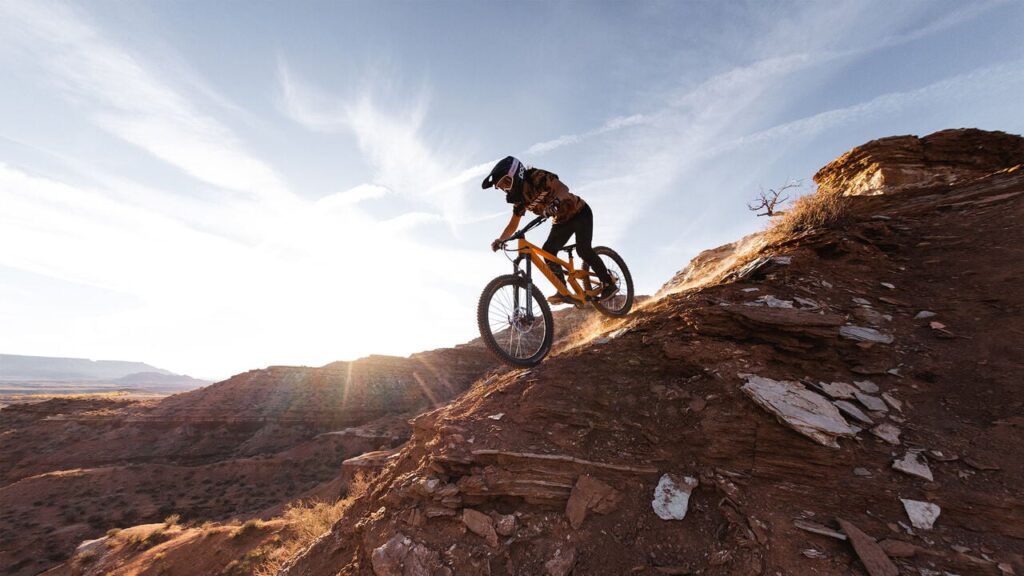


- Bike Selection
- Essential Gear
Bike Selection
Choosing the right bike for freeride mountain biking is like picking the perfect partner for an adventure. Here’s a simple guide:
Type of Bike:
Freeride bikes are like the all-rounders of the mountain biking world. They’re sturdy and versatile, designed for both uphill climbs and thrilling descents.
Suspension:
Look for a bike with full suspension. This means it has shock absorbers in both the front fork and the rear, providing a smoother ride on rough trails.
Frame Material:
Opt for a frame made of aluminum or carbon fiber. They are light, durable, and can handle the bumps and jumps of freeriding.
Wheel Size:
Choose 27.5 or 29-inch wheels for better stability and control. They roll over obstacles more easily, making your ride smoother.
Essential Gear
Before hitting the trails, make sure you’ve got the right gear. Safety and comfort come first:
Helmet:
Your brain’s best friend. Always wear a well-fitted helmet to protect your noggin in case of falls.
Gloves:
Keep your hands happy. Gloves with good grip help you control the bike and protect your hands in case of a spill.
Pads and Armor:
Elbow and knee pads, along with body armor, shield you from scratches, bruises, and unexpected encounters with the ground.
Shoes:
Sturdy, flat-soled shoes provide grip on the pedals. Some riders prefer shoes with ankle protection for added support.
Eyewear:
Sunglasses or goggles keep dirt and debris out of your eyes. They also make you look cool, which is a bonus!
Hydration Pack:
Stay fueled and hydrated. A backpack with a water bladder ensures you’re ready for the ride without lugging around a water bottle.
You May Also Like : ( How To Get Into Downhill Mountain Biking )
Finding the Right Trail



- Understanding Trail Types
- Trail Difficulty Levels
Understanding Trail Types
Think of mountain biking trails like different flavors of ice cream – each one offers a unique experience. Here’s a quick guide to the various types:
Cross-Country Trails (XC):
These trails are like the vanilla of mountain biking. They are longer, flatter, and focus on endurance. Great for a scenic ride through the woods.
Downhill Trails (DH):
Imagine the chocolate fudge of trails. These are steep, thrilling descents that get your adrenaline pumping. Usually accessed by a lift or shuttle.
Freeride Trails:
Freeride is like the mixed berry sorbet. These trails often have jumps, drops, and technical features. Perfect for riders who love a bit of everything.
Trail Centers:
Picture the Neapolitan of trails. Trail centers have a mix of trail types, facilities, and are often well-marked, making them great for riders of all levels.
Singletrack:
The classic strawberry trail. Narrow paths winding through forests or mountains. It’s all about flow and maneuvering around obstacles.
Trail Difficulty Levels
Just like video games, mountain biking trails come with difficulty levels. Here’s an easy breakdown:
Green (Easy):
The green trail is like the beginner level. Smooth, flat, and friendly for those starting out. It’s the training ground for new riders.
Blue (Intermediate):
The blue trail is like moving up to the next level in a game. It has some challenges – maybe a few rocks and roots – but nothing too crazy.
Black (Advanced):
Think of the black trail as the expert level. It’s for riders who want a serious challenge – steep descents, technical sections, and maybe some jumps.
Double Black (Expert/Pro):
Double black trails are like the final boss in a game. They’re intense, with big jumps, drops, and extremely challenging features. Not for the faint of heart!
Mastering the Techniques
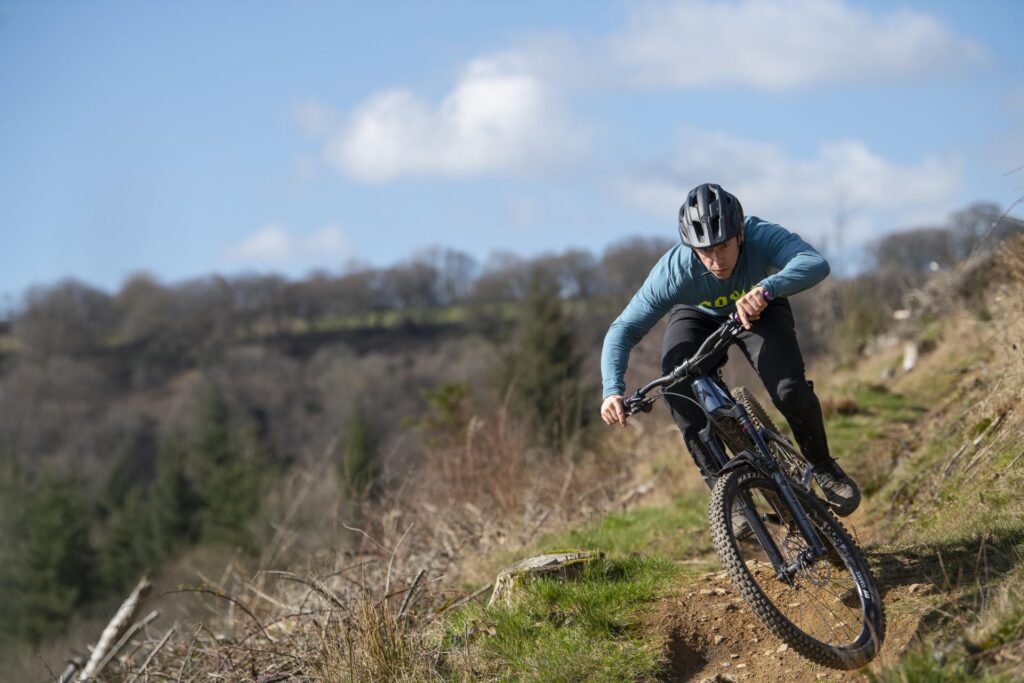


- Jumping Fundamentals
- Cornering Like a Pro
Jumping Fundamentals
Jumping on a mountain bike is like catching air on a skateboard – it’s all about style and control. Here’s a simple guide to jumping:
Body Position:
Pretend you’re a superhero in flight. Keep your body centered, knees and elbows slightly bent. This helps you stay in control.
Approach the Jump:
Hit the jump with a bit of speed, but not too fast. Approach it with confidence, looking ahead to where you want to land.
Takeoff:
As you reach the lip of the jump, imagine you’re standing up a bit on your pedals. This helps your bike leave the ground smoothly.
In the Air:
Keep your eyes on the landing spot. To level your bike, bring it up with your feet, almost like you’re bringing your knees to your chest.
Landing:
Bend your knees as you touch down. It’s like absorbing the landing to make it smoother. Land both wheels at the same time for a clean touchdown.
Cornering Like a Pro
Mastering corners is like navigating a twisty road in a sports car – it’s all about finesse and speed. Here’s how to corner like a pro:
Look Ahead:
Keep your eyes on the exit of the turn. Your bike tends to follow where you’re looking, so focus on where you want to go.
Body Position:
Lean your bike, not your body. Shift your weight slightly to the outside of the turn, keeping your inside knee up.
Braking Before the Turn:
Slow down before entering the corner. It’s easier to control your speed beforehand than trying to brake in the middle of a turn.
Entry Point:
Start wide and cut in. Enter the turn from the outside, aiming to hit the apex (the innermost point of the turn).
Exiting the Turn:
Accelerate smoothly as you exit the turn. Your bike will naturally straighten out as you gain speed.
Bike Maintenance Tips
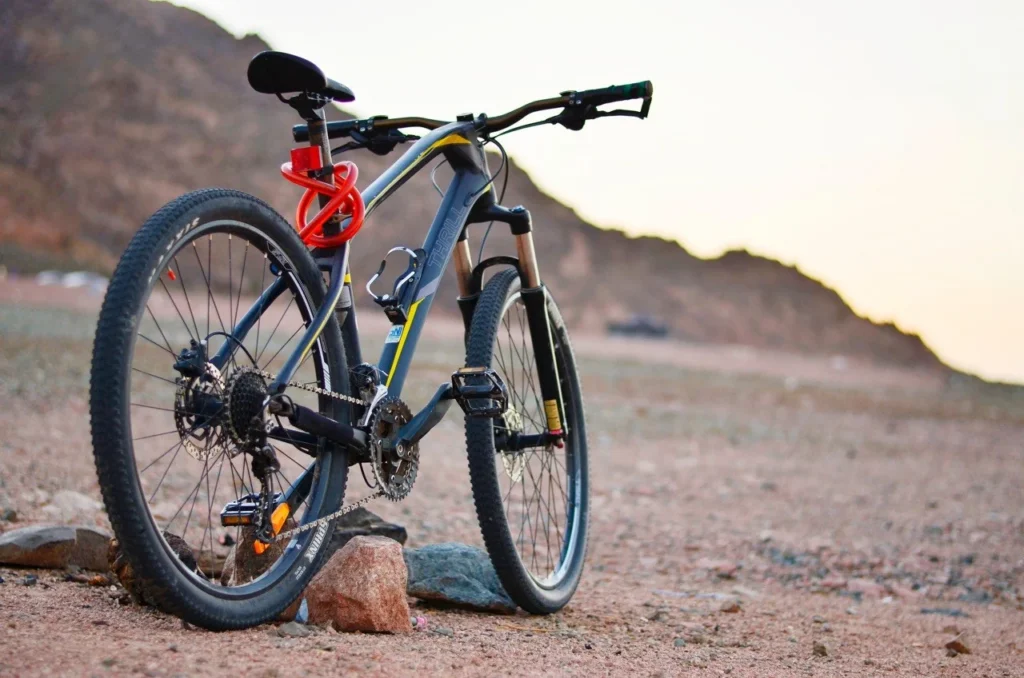


- Keeping Your Ride in Top Shape
- Troubleshooting on the Trail
Keeping Your Ride in Top Shape
Maintaining your mountain bike is like giving it a little love to keep it running smoothly. Here are some easy tips:
Clean Your Bike:
Grab a bucket, some soap, and a brush. Clean off the dirt and grime after a ride. A clean bike works better and looks cooler!
Check Your Tires:
Make sure they’re inflated properly. Too much or too little air affects your ride. Use a pump and keep an eye on the recommended pressure.
Inspect the Chain:
Look at your chain. Is it clean and lubed? If not, add some bike chain lube to keep it running smoothly. Wipe off any excess.
Brake Check:
Squeeze your brakes. Do they feel firm, or is it a bit squishy? If it’s squishy, you might need to adjust or replace your brake pads.
Gears and Shifters:
Test your gears by shifting through them. They should change smoothly. If it’s clunky, you might need a tune-up.
Tighten Bolts:
Give your bike a shake. Any rattles or wobbles? Tighten up loose bolts to keep everything secure.
Troubleshooting on the Trail
Sometimes, things go wonky when you’re out on the trail. Here’s how to handle common issues:
Flat Tire:
Pack a spare tube, tire levers, and a pump. If you get a flat, remove the tire, replace the tube, and inflate it.
Chain Issues:
If your chain comes off, carefully put it back on. If it keeps happening, you might need to adjust your derailleur.
Brake Problems:
If your brakes feel off, check for rubbing or misalignment. If you can’t fix it on the trail, ride carefully and get it looked at later.
Strange Noises:
Clicks, creaks, or clunks? Try to identify the source. It might be something simple like a loose bolt or a bit of dirt.
Progressing Your Skills
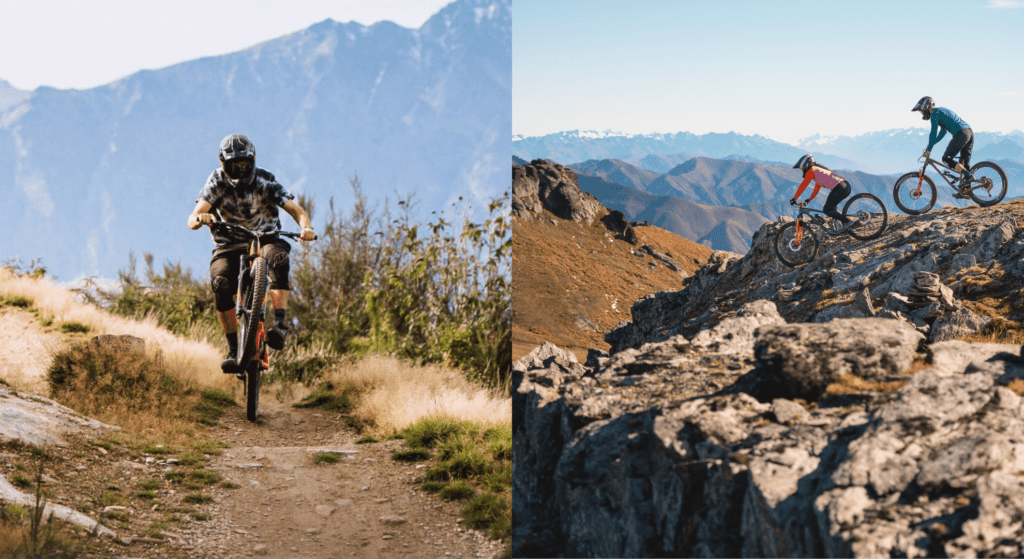


- Gradual Skill Advancement
- Setting Personal Goals
Gradual Skill Advancement
Becoming a mountain biking ninja doesn’t happen overnight. It’s about leveling up your skills step by step. Here’s your guide:
Start Small:
Begin with the basics. Ride easy trails, practice handling your bike, and get comfortable with different terrains.
Learn New Techniques:
Once you’ve mastered the basics, start learning new skills like jumping, cornering, and riding on challenging surfaces. Practice makes progress!
Challenge Yourself:
Push your limits gradually. If you’re comfortable with small jumps, try slightly bigger ones. Gradually take on more technical trails.
Ride Regularly:
Consistency is key. The more you ride, the more confident and skilled you become. It’s like gaining experience points in a video game.
Seek Guidance:
Don’t be afraid to ask experienced riders for tips. Joining a biking group or taking lessons can help you progress faster.
Setting Personal Goals
Imagine you’re on a quest in a game, but instead of defeating monsters, you’re conquering trails. Here’s how to set and achieve your mountain biking goals:
Define Your Goals:
What do you want to achieve? Whether it’s conquering a challenging trail, mastering a new technique, or improving your speed, set clear goals.
Break it Down:
Divide big goals into smaller, achievable tasks. Want to nail a jump? Start with smaller jumps and work your way up.
Track Your Progress:
Keep a biking diary or use apps to track your rides and accomplishments. It’s like leveling up and unlocking achievements.
Celebrate Success:
When you achieve a goal, celebrate! Treat yourself to a snack, share your success with friends, or simply enjoy the satisfaction of accomplishment.
Adapt and Evolve:
As you achieve goals, set new ones. This keeps the excitement alive and ensures a continuous journey of improvement.
Joining the Freeride Community
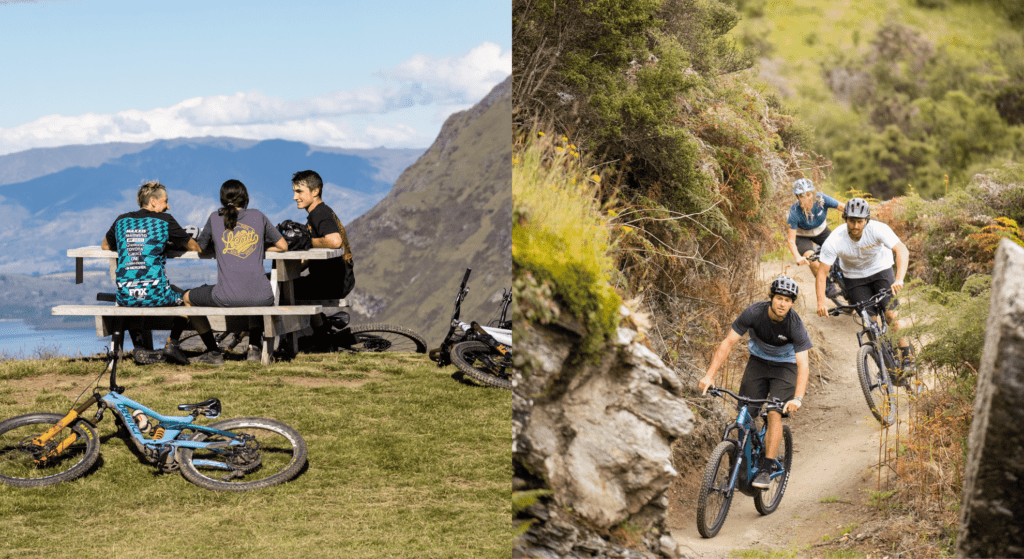


- Local Riding Groups
- Events and Competitions
Local Riding Groups
Being part of a mountain biking crew is like having a squad in a video game – it makes the adventure even more epic. Here’s how to find and join local riding groups:
Check Social Media:
Look for biking groups on platforms like Instagram or Facebook. Joining these groups lets you connect with riders in your area.
Visit Local Bike Shops:
Bike shops are like the hangout spots for riders. Check bulletin boards or ask the staff about group rides or events.
Attend Group Rides:
Many communities organize regular group rides. Join in! It’s a fantastic way to meet fellow riders, share tips, and explore new trails together.
Be Friendly and Open:
Don’t be shy! Strike up conversations with other riders. Everyone started as a beginner, and most riders are stoked to welcome newcomers.
Respect the Trails:
Being part of a riding community means respecting nature and the trails. Follow trail etiquette and leave no trace behind.
Events and Competitions
Imagine mountain biking events as the grand tournaments in your favorite game – full of challenges, cheers, and a chance to show off your skills. Here’s how to get involved:
Check Event Calendars:
Look for local biking events on websites, social media, or at your bike shop. Events range from casual rides to more competitive races.
Start with Fun Rides:
Participate in fun rides or charity events to get a taste of the event scene. It’s a low-pressure way to enjoy biking with others.
Enter Local Competitions:
Feeling confident? Join local competitions. These can include races, freeride contests, or skills challenges.
Meet Like-Minded Riders:
Events are fantastic opportunities to connect with riders who share your passion. You might make new friends or find potential riding buddies.
Enjoy the Experience:
Whether you’re aiming for the podium or just out to have fun, enjoy the experience. Events are about celebrating the joy of mountain biking.
Stories from the Trail



- Real-Life Experiences
- Learning from Mistakes
Real-Life Experiences
Picture this section like swapping epic gaming stories with your friends, but it’s all about mountain biking adventures. Here are some real-life experiences from the trails:
The First Big Jump:
Imagine standing at the top of a jump that looked massive. Heart racing, butterflies in the stomach. But you went for it, and the feeling of soaring through the air was indescribable. Lesson: Courage pays off!
Unexpected Wildlife Encounter:
Riding through the woods, you stumbled upon a deer or a curious squirrel. Nature surprises on the trail are like bonus levels – unexpected but awesome.
Conquering a Challenging Trail:
That one trail everyone said was tough? You tackled it, maybe fell a couple of times, but you made it to the end. Victory tastes sweet!
Night Riding Adventure:
Ever tried biking under the moonlight? It’s a whole different experience. The dark trails, the sounds of the night – it’s like being in a mystery game.
Getting Lost and Finding Your Way:
Took a wrong turn, got a bit lost, but discovered a new hidden trail. Sometimes mistakes lead to the coolest discoveries.
Learning from Mistakes
In the world of mountain biking, making mistakes is like respawning in a game – it happens, but it’s how you learn and grow. Here are some common mistakes and the lessons they teach:
Overestimating Skills:
Tried a jump that was a bit too advanced? It’s okay. Lesson: Progress gradually, and there’s no shame in taking it slow.
Forgetting Essential Gear:
Ever left home without your helmet or gloves? Lesson: Always double-check your gear. Safety first!
Ignoring Bike Maintenance:
Neglected to check your bike, and it broke down mid-ride? Lesson: Regular maintenance keeps your ride smooth and trouble-free.
Not Knowing Trail Difficulty:
Took on a trail that was way too advanced? Lesson: Always check trail ratings and start with what matches your skill level.
Underestimating Nature:
Got caught in the rain without rain gear? Lesson: Nature is unpredictable; be prepared for anything.
Conclusion
In conclusion, freeride mountain biking is not just a sport; it’s a thrilling adventure that takes riders on a journey through diverse terrains, challenging trails, and the highs of conquering gravity-defying obstacles.
It’s the art of mastering the bike, soaring through the air, and feeling the rush of adrenaline as you navigate downhills and conquer challenging features. So, if you find yourself pondering, “What is Freeride Mountain Biking?”.
It’s an exhilarating journey where gravity becomes your playground, the trail becomes your canvas, and every ride is a chance to experience the joy of pushing your limits and discovering the true essence of freedom on two wheels.
FAQ’s
Q: What is Freeride Mountain Biking?
ANS: Freeride mountain biking is an adrenaline-fueled discipline where riders navigate diverse terrains, conquering challenging trails, and executing daring jumps and maneuvers, showcasing skill, creativity, and a love for adventure.
Q: Is freeride mountain biking suitable for beginners?
ANS: Beginners can start with basic trails, gradually progressing to more challenging features. It’s important to build skills and confidence before attempting advanced freeride elements.
Q: How can riders join the freeride mountain biking community?
ANS: Riders can connect through social media, local bike shops, or by participating in group rides and events. Building relationships with experienced riders fosters community involvement.
Q: Are there environmental considerations in freeride mountain biking?
ANS: Yes, responsible riding is crucial. Following trail etiquette, respecting wildlife, and adhering to sustainable practices help preserve the natural beauty of trail systems for future generations.



Welcome to Bikegenics, where passion meets performance! We are a leading online destination for all things related to mountain biking, dedicated to providing you with top-notch gear, expert advice, and an immersive community to fuel your two-wheeled adventures. With a commitment to excellence and a deep love for the sport, we strive to elevate your biking experience to new heights.
